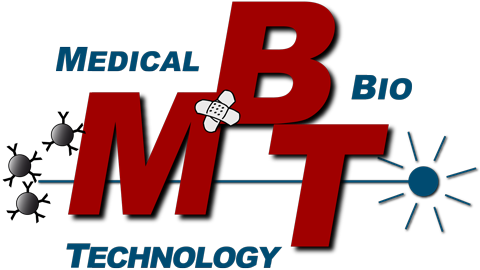Bone Tissue Engineering
There is a great and increasing demand for bone substitute tissues, i.e. implantable, personalized artificial tissues, which promise faster healing and better integration into the body compared to conventional auto-/allografts. Bone tissue has a characteristically ordered cellular and macromolecular structure to define its diverse, i.e. biomechanical properties (structure-function relationship). The extracellular matrix (ECM) of bone consists mostly of collagen-I fiber arrays incorporating inorganic hydroxyapatite crystals. Recapitulating this structure is key in engineering of artificial bone tissue.
The goal of our group is to investigate bone formation (osteogenesis) on both a biological and a process engineering level. For this, bioreactor environments are explored and methods and tools developed to facilitate the formation of advanced quality bone tissue using dynamic tissue culture. This is implemented by mini-bioreactors enabling microfluidic, biomechanical and biochemical tissue stimulation, which are additionally equipped with optical sensor technology to monitor physiological parameters. Process quality is determined by measuring the distribution, adhesion, proliferation and viability of cells in 3D-printed biocompatible scaffolds, and the expression of certain osteogenic markers. We are interested in how mechanical stimulation improves osteogenesis together with the formation of bone-like fibrillar collagen-I networks. In this context, it is also of interest how mechanical stimulation is perceived and processed by the cells (mechanotransduction).
Perfusion and compression stimulation of artificial bone tissue
For conditioning the development of bioartificial bone of better quality, biomechanical stimulation is used. For this, a multifunctional biochamber was designed that contains sensors for monitoring (local) concentrations of O2/CO2 or pH and offers the possibility of imaging. This biochamber takes up cubic scaffolds of defined geometry pre-seeded with cells and is perfusable. It is part of the TissuePrimer device prototype which allows to execute defined biomechanical compression and perfusion patterns on the cell-seeded constructs.
For testing different perfusion conditions and programs in parallel, a perfusion multi-chamber was designed and integrated in a perfusion circuit driven by a multi-channel peristaltic pump. Both systems, TissuePrimer and multi-chamber circuit, allow to investigate and quantitatively validate the influence of mechanical stimulation on bone cell physiology. Perfusion conditions are modeled and optimized using software simulations (Ansys). The mentioned systems are continuously improved and will be expanded into an automatable, self-learning system that autonomously produces engineered bone tissue of a high quality level.
Improvement of 3D tissue culture and tracking of bone tissue formation
Suitable scaffold materials and architectures are necessary for dynamic 3D culture. Scaffold geometries are designed and adapted using 3D printing, and scaffold surfaces are optimized using coating with ECM proteins. Both cell proliferation and osteogenic differentiation within the scaffold pores are monitored using suitable assays, while oxygen consumption by cells can be followed online. Selected osteogenic markers are used for quantification including ALP activity assay, ELISA assays and fluorescence imaging of hydroxyapatite formation.
Studies of the assembly and remodeling of ECM and cell arrangement during osteogenic differentiation established the matrix morphology to be a suitable marker for bone maturation that can predict the stability and strength of the forming tissue. For this, collagen-I fiber networks are visualized in 3D by multiphoton SHG imaging, and different features are quantitated including network morphology (e.g. orientation, anisotropy), fiber abundance and fiber thicknesses using tools in ImageJ software and newly developed algorithms. These tools help to optimize the formation of bone-specific matrix (ECM biotechnology).
Past projects using multiphoton imaging:
- Microstructure analysis of bacterial nanocellulose as carrier for barrier tissue models
- Microscopic investigation of different hydrogels for soft tissue engineering
- Microstructure analysis of bone explants to test the efficiency of the procedure
Selected publications:
- Vielreicher M, Schuermann S, Detsch R, Buttgereit A, Boccaccini A, Friedrich O (2013). Taking a deep look: modern microscopy technologies to optimize the design and functionality of biocompatible scaffolds for tissue engineering in regenerative medicine. J R Soc Interface; 10(86): 20130263. (combined review/research article) doi: 10.1098/rsif.2013.0263
- Vielreicher M, Gellner M, Rottensteiner U, Horch RE, Arkudas A, Friedrich O (2017). Multiphoton microscopy analysis of extra-cellular collagen-I network formation by mesenchymal stem cells. J Tissue Eng Regen Med. Jul; 11(7): 2104-2115. doi: 10.1002/term.2107. Epub 2015 Dec 29
- Vielreicher M, Kralisch D, Völkl S, Sternal F, Arkudas A, Friedrich O (2018). Bacterial nanocellulose stimulates mesenchymal stem cell expansion and formation of stable collagen-I networks as a novel biomaterial in tissue engineering. Scientific Reports. 2018 Jun 20;8(1):9401. doi: 10.1038/s41598-018-27760-z
- Li JJ, Akey A, Dunstan CR, Vielreicher M, Friedrich O, Bell DC, Zreiqat H (2018). Effects of material-tissue interactions on bone regeneration outcomes using baghdadite implants in a large animal model. Adv Healthc Mater. 2018 Aug;7(15):e1800218. Epub 2018 Jun 6). doi: 10.1002/adhm.201800218
- Fey C, Betz J, Rosenbaum C, Kralisch D, Vielreicher M, Friedrich O, Metzger M, Zdzieblo D (2020). Bacterial nanocellulose as novel carrier for intestinal epithelial cells in drug delivery studies. Materials Science and Engineering: C (Materials for Biological Applications). 2020 Apr; 109:110613. Epub 2019 Dec 30. doi: 10.1016/j.msec.2019.110613
- Vielreicher M, Bozec A, Schett G, Friedrich O (2021). Murine Metatarsus Bone and Joint Collagen-I Fiber Morphologies and Networks Studied With SHG Multiphoton Imaging. Frontiers in Bioengineering and Biotechnology. 2021 Jun 11;9:608383. doi: 10.3389/fbioe.2021.608383
